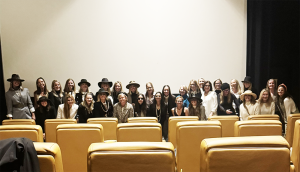Branham: Our bears are hungry

Courtesy photo
Last night, I nearly ran over a mother bear with two cubs behind the Jerome Hotel. The three shadows had eyes, and they looked terrified as they scurried off into the lawn of a home. The two cubs hid behind the mother as they all tried to disappear behind a tree. They looked so wildly out of place. I could feel the mother’s instinct to help her children survive, but I knew what was at stake. My heart sank.
Bear reports in Eagle and Pitkin counties more than tripled between 2022 and 2024, jumping from 274 to 842 — a 207% increase, according to Colorado Parks and Wildlife. Why such an increase? Last spring’s late frosts wiped out berry and acorn crops. By late summer, mother bears were doing something heartbreaking: abandoning their cubs to survive.
“This behavior is generally associated with poor natural food conditions causing sows to prioritize their own survival over their offspring,” says CPW Wildlife Manager Matt Yamashita.
Was the mother bear I saw running out of food options? Would she be forced to abandon her cubs?
Although it’s normal for animals to start moving to lower elevations as winter approaches, the increase in bear visibility is mainly tied to food shortages because of climate change. This year’s severe drought means drastically fewer berries and less food. Bears coming this deep into town can only mean one thing: They’re desperate.
This worries me because more bears around people means more chances for encounters that go awry. As always, it will be the bears that suffer. But we can help.
Don’t approach them for photos — although black bears are not violent, a frightened bear may try to defend itself. Do not, whatever you do, feed the bears. This will risk their lives. Secure your trash in bear-resistant trash containers. Lock your doors and windows. We do these things to protect them, not us. The best way to live in harmony with our bears is to remember they are wild animals, to not habituate them to humans, and respect them with a distance.
Colorado Parks and Wildlife have a “two-strike” policy and an immediate euthanasia policy if the bear is deemed a threat to human safety. You can make sure this does not happen by keeping food sources out of reach. You can help the bears live.
Bears are considered an indicator species. Their health and population trends reflect the overall health of the ecosystem and habitat. When I see the mother bear and her two cubs behind the Jerome, I see a Roaring Fork Valley in trouble.
But I also see a choice. Every unlocked door and unsecured trash can will determine if those cubs live or die.
It is a privilege to live in a valley with wild animals. That mother bear is doing her best to protect her cubs from starvation. It’s the least we can do to protect them from us.
Dr. Lindsay Branham is an environmental psychologist, scholar, author, and Emmy-nominated filmmaker whose work explores embodied kinship between humans and the Earth. Subscribe to her Substack at lindsaybranham.substack.com.
Pitkin County emergency dispatch director sees national recognition
A high performing 911 center and positive workplace culture don’t have to be mutually exclusive. That’s the philosophy proven by the director of Pitkin County Regional Emergency Dispatch Center, Brett Loeb, who was just recognized nationally as the 2025 Public Safety Answering Point Finest Director of the Year by NiCE Public Safety — an organization that recognizes emergency communications excellence.










